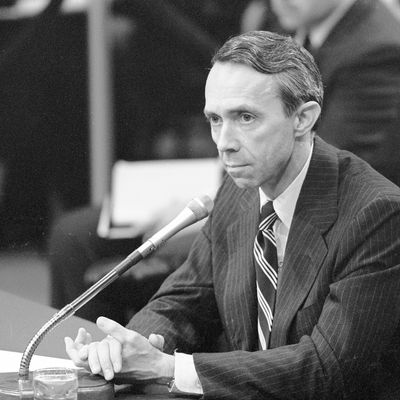

David Souter throughout his Senate affirmation hearings in 1990.
Picture: CQ-Roll Name/Getty Pictures
David Souter, the previous U.S. Supreme Courtroom justice who retired on the age of 69 and died this week at 85, was considered by liberals as a person of conservative temperament, if not essentially conservative views. New York Occasions authorized columnist Linda Greenhouse introduced this tackle Souter succinctly:
Justice Souter portrayed himself as he was: a choose of mainly conservative instincts who took as his position mannequin Justice John Marshall Harlan II, a distinguished New York lawyer and an Eisenhower appointee who was usually in dissent throughout the heyday of Supreme Courtroom liberalism underneath Chief Justice Earl Warren.
Justice Harlan nonetheless considered the Structure as a constitution of “ordered liberty,” the that means of which may evolve over time to embody ideas not explicitly talked about within the textual content, equivalent to the fitting to privateness. David Souter noticed the Structure in the identical mild. Solely within the more and more partisan and polarized local weather of the Nineteen Nineties and later may an interpretive stance that was as soon as so extensively held as barely debatable come to be considered because the hallmark of a judicial liberal.
To conservatives, Souter wasn’t only a “judicial liberal” appointed by a Republican president. They have been used to that, since Dwight D. Eisenhower positioned Earl Warren and William Brennan on the Courtroom, and Richard M. Nixon was answerable for Roe v. Wade’s principal writer Harry Blackmun. What made Souter an everlasting cautionary story for the fitting was his alleged “stealth” liberalism. George H.W. Bush appointed Souter principally as a result of he was assured that the comparatively obscure New Hampshire choose can be a stable selection by Granite State senator Warren Rudman, and by Rudman’s pal, White Home chief of workers John Sununu. Souter’s comparatively restricted report and public profile made him a pretty choose on the time, as fiery liberal opposition had just lately introduced down Ronald Reagan’s Courtroom nominee, Robert Bork. Souter was simply confirmed, with each single Senate Republican voting for him.
When Souter’s liberalism, significantly on abortion rights, grew to become obvious, the conservative fury aimed toward Bush — already a suspect determine on the fitting for many years — was intense. However even earlier than he outraged the fitting by serving to save abortion rights within the 1992 choice Deliberate Parenthood v. Casey, Souter’s heterodoxy was obvious sufficient that it influenced Bush’s subsequent Supreme Courtroom choose. Clarence Thomas was seen as each an applicable successor to the primary Black justice, Thurgood Marshall, and a severe ideological conservative. Thus, Souter inadvertently teed up the lengthy profession of probably the most intensely conservative justice for the reason that nineteenth century.
The rising sense that each Bush and Souter had betrayed the conservative trigger, as a part of a lengthy sample of Supreme Courtroom perfidy by GOP presidents, led to calls for for severe and clear ideological vetting of potential justices going ahead. For some time, the lengthy custom of treating judicial nominations as apolitical and even bipartisan inhibited such calls for. However “no extra Souters” grew to become a robust conservative rallying cry. The yearslong escalation of the fitting’s vetting calls for culminated within the three justices appointed by Donald Trump, after he outsourced the vetting course of to the Federalist Society and the Heritage Basis.
So placing apart his particular influence on the Courtroom and on constitutional regulation throughout 18 momentous years on the Supreme Courtroom, David Souter was in lots of respects the final Supreme Courtroom nominee from both social gathering who may very well be nominated and confirmed with out intense partisan and ideological scrutiny. Souter himself could have mirrored this along with his choice to retire from the Courtroom quickly after Barack Obama was elected president, making certain one other liberal (on this case, Sonia Sotomayor) joined the Courtroom. It was one remaining gesture of quiet defiance to the conservatives who made his identify a curse.



